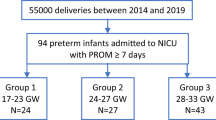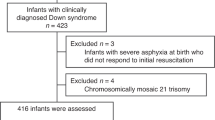Abstract
OBJECTIVE: To assess if there have been changes in survival, demographic data, obstetric features, neonatal morbidity, and short-term neurologic/radiographic/neurosensory outcome of 500- to 800-g infants born in a tertiary care neonatal center from 1990 through 1998.
STUDY DESIGN: Records of all 500- to 800-g infants born at North Shore University Hospital during 1990–1998 were reviewed to determine demographic data, survival by weight and gestational age (GA), obstetric features, neonatal morbidity, and short-term neurologic/radiographic/neurosensory outcome. Newborn infants were grouped into three triennia: 1990–1992, 1993–1995, and 1996–1998 and compared across time.
RESULTS: Of the 173 infants admitted to the neonatal intensive care unit, 112 survived. Improved survival was documented: 40% in 1990–1992, 73% in 1993–1995, and 81% in 1996–1998 (p<0.0001). Improved survival was also noted in each of the three weight cohorts, as well as in infants ≤26 weeks GA. An increased use of antenatal corticosteroids and increased number of deliveries by cesarean section (C/S) were noted across time. The incidence of 0 to 3 Apgar scores at both 1and 5 minutes decreased across time. Necrotizing enterocolitis in survivors and expected short-term neurologic/radiographic/neurosensory outcome improved between 1990–1992 and 1996–1998, with a trend toward reduced IVH grade III to IV. The incidence of other neonatal morbidities did not change throughout the time period.
CONCLUSIONS: The data document that survival rates continued to improve for 500- to 800-g infants throughout the 1990s. This was concurrent with an increase in “low-risk, expected normal” infants, increased number of deliveries by C/S, decreased incidence of low Apgar scores at both 1 and 5 minutes, and an increased use of antenatal corticosteroids.
This is a preview of subscription content, access via your institution
Access options
Subscribe to this journal
Receive 12 print issues and online access
$259.00 per year
only $21.58 per issue
Buy this article
- Purchase on Springer Link
- Instant access to full article PDF
Prices may be subject to local taxes which are calculated during checkout


Similar content being viewed by others
References
LaPine TR, Jackson JC, Bennett FC . Outcome of infants weighing less than 800 grams at birth: 15 years' experience Pediatrics 1995 96: 479–83
Battin M, Ling EWY, Whitfield MF, MacKinnon M, Effer SB . Has the outcome for extremely low gestational age (ELGA) infants improved following recent advances in neonatal intensive care? Am J Perinatol 1998 15: 469–77
The Victorian Infant Collaborative Study Group Doyle LW . Improved outcome into the 1990's for infants weighing 500–999 grams at birth Arch Dis Child 1997 77: F91–4
Hack M, Friedman H, Fanaroff A . Outcomes of extremely low birth weight infants Pediatrics 1996 98: 931–7
Kramer WB, Saade GR, Goodrum L, Montgomery L, Belfort M, Moise KJ . Neonatal outcome after active perinatal management of the very premature infant between 23 and 27 weeks gestation J Perinatol 1997 17: 439–43
Bottoms SF, Paul RH, Iams JD et al. Obstetric determinants of neonatal survival: Influence of willingness to perform caesarian delivery on survival of extremely low birth weight infants Am J Obstet Gynecol 1997 176: 960–6
Kitchen W, Ford GW, Doyle LW et al. Caesarian section or vaginal delivery at 24 to 28 weeks' gestation: comparison of survival and neonatal and two-year morbidity Am J Obstet Gynecol 1985 66: 149–57
Amon E, Sibai BM, Anderson GD, Mabie WC . Obstetric variables predicting survival of the immature newborn (≤1000 g): a five-year experience at a single perinatal center Am J Obstet Gynecol 1987 156: 1380–9
Lubchenco LO, Hansman C, Boyd E . Intrauterine growth in length and head circumference as estimated from live births at gestational ages from 26–42 weeks Pediatrics 1966 37: 403–8
Boyle RJ, Oh W . Respiratory distress syndrome Clin Perinatol 1978 5: 283–7
Shennan AT, Dunn MS, Ohlsson A, Lennox K, Hoskins EM . Abnormal pulmonary outcomes in premature infants: prediction from oxygen requirement in the neonatal period Pediatrics 1988 82: 527–32
Bell MJ, Ternberg JL, Feigin RD et al. Neonatal necrotizing entercolitis: therapeutic decision based upon clinical staging Ann Surg 1978 187: 1–7
Papile LA, Burnstein J, Burnstein R, Koffler H . Incidence and evolution of subependymal and intraventricular hemorrhage: a study of infants with birth weights less than 1500 g J Pediatr 1978 92: 529–34
Papile LA, Munsick-Bruno G, Schaefer A . Relationship of cerebral intraventricular hemorrhage and early childhood neurological handicaps J Pediatr 1983 103: 273–7
Volpe J . Brain injury in the premature infant Clin Perinatol 1997 24: 567–87
Graziani LJ, Pasto M, Stanley C et al. Neonatal neurosonographic correlates of cerebral palsy in preterm infants Pediatrics 1986 78: 88–95
Whitaker AH, Feldman JF, Van Rossem RV et al. Neonatal cranial ultrasound abnormalities in low birth weight infants: relation to cognitive outcomes at six years of age Pediatrics 1996 98: 719–29
The International Committee for the Classification of Retinopathy of Prematurity. An international classification of retinopathy of prematurity Pediatrics 1984 74: 127–33
Shankaran S, Koepke T, Woldt E et al. Outcome after posthemorrhagic ventriculomegaly in comparison with mild hemorrhage without ventriculomegaly J Pediatr 1989 114: 109–14
Hack M, Fanaroff AA . Outcomes of children of extremely low birth weight and gestational age in the 1990s Semin Neonatol 2000 5: 89–106
Cuzick J . A Wilcoxon-type test for trend Stat Med 1985 4: 87–90
Maher JE, Cliver SP, Goldenberg RL, Davis RO, Copper RL and the March of Dimes Multicenter Study Group. The effect of corticosteroid therapy in the very premature infant Am J Obstet Gynecol 1994 170: 869–73
Rennie JM, Wheater M, Cole TJ . Antenatal steroid administration is associated with an improved chance of intact survival in preterm infants Eur J Pediatr 1996 155: 576–9
Stevenson DK, Wright LL, Lemons JA et al. Very low birth weight (VLBW) outcomes of the NICHD neonatal research network, January 1993 through December 1994 Am J Obstet Gynecol 1998 179: 1632–9
O'Shea TM, Klinepeter KL, Goldstein DJ, Jackson BW, Dillard RG . Survival and developmental disability in infants with birth weights of 501 to 800 g, born between 1979 and 1994 Pediatrics 1997 100: 982–6
Wilson DC, McClure G . Babies born under 1000 g — perinatal outcome Ulster Med J 1996 65: 118–22
Horbar JD, Rogowski J, Plsek PE et al. Collaborative quality improvement for neonatal intensive care Pediatrics 2001 107: 14–22
Piecuch RE, Leonard CH, Cooper BA, Sehring SA . Outcome of extremely low birth weight infants (500–999 grams) over a 12-year period Pediatrics 1997 100: 633–9
Author information
Authors and Affiliations
Rights and permissions
About this article
Cite this article
Harper, R., Rehman, K., Sia, C. et al. Neonatal Outcome of Infants Born at 500 to 800 Grams From 1990 Through 1998 in a Tertiary Care Center. J Perinatol 22, 555–562 (2002). https://doi.org/10.1038/sj.jp.7210789
Published:
Issue Date:
DOI: https://doi.org/10.1038/sj.jp.7210789
This article is cited by
-
Decreasing trend in postneonatal mortality
Journal of Perinatology (2008)
-
Survival and major neurodevelopmental impairment in extremely low gestational age newborns born 1990–2000: a retrospective cohort study
BMC Pediatrics (2007)
-
Prognose extrem unreifer Frühgeborener
Monatsschrift Kinderheilkunde (2005)
-
Hospital Survival of Very-Low-Birth-Weight Neonates from 1977 to 2000
Journal of Perinatology (2004)



